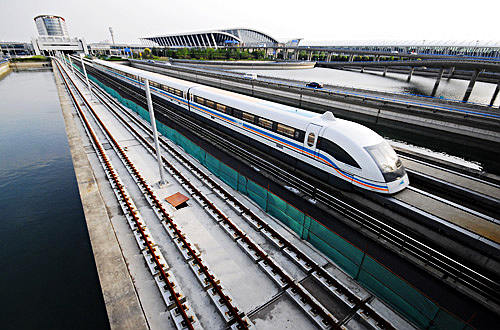|
 |
|
THE COST OF SPEED: A maglev train pulls out of Pudong Airport in Shanghai. Plans for Beijing's first maglev line have met vehement resistance from residents along the planned rail route (XINHUA) |
Plans for Beijing's first maglev line, despite providing efficient and record-speed transportation across the Chinese capital, is meeting fierce resistance from residents along the proposed route. Concerns stem from possible exposure to radiation produced by the maglev train.
The project, called the S1 Line, aims to include Beijing's western suburbs into the city's urban rail transport network. China's independently developed technologies will highlight the construction of the low-to-medium-speed magnetic levitation (maglev) train. Expected to run at 150 km per hour, S1 Line trains will have two operating systems— manual and automatic.
The maglev train has several advantages over conventional trains. The cost for the maglev line is around 400 million yuan ($58.6 million) per km, far less than the 600-800 million yuan ($87.8-117 million) price tag that comes with subway rail. The maglev train can easily run through dense residential areas with a minimum turning radius of 75 meters, while subways and urban trains require 300 meters. Additionally, the maglev train suits areas with complex geological surroundings where tunneling can be somewhat challenging.
But residents aren't buying it, even though these merits make the maglev line Beijing's top choice in terms of high-speed city transportation.
Objection
Construction of the S1 Line has been assigned to Beijing Infrastructure Investment Co. Ltd., while the Environmental Assessment and Engineering Center (EAEC) of the China Academy of Railway Sciences (CARS) has been entrusted with assessing the project's impact on the environment.
The academy released an assessment report on its website on May 6, inviting the citizens to provide their opinion and ask questions about the S1 Line's environmental impact.
Anxieties were high among residents pertaining to the maglev line's influence on their health, said Zhao Lei, who lives in an apartment in the China House residential compound. The S1 Line will run through his compound and nearby Bisenli residential compound, with only 30 meters separating the residents from the maglev line.
Residents in the two residential compounds and some other housing projects along the line signed a letter of protest and sent it to the academy, the Beijing Infrastructure Investment Co. Ltd. and relevant departments of the Beijing Municipal Government. They have also taken their opposition online.
From the letter's first sentence, the residents' stance is clear: "We the residents along the maglev line—a severe environmental and health menace to us—firmly oppose the decision."
They outlined four primary reasons for their opposition.
First and foremost was the fear of exposure to unknown amounts of radiation. The safety of maglev technologies has yet to be proved for wide application because of a lack of statistical data to define radiation pollution and associated harm, said the letter.
The letter also raised questions concerning the government's ability to assess harm to regular passengers from potential radiation exposure and also provide medical support should the project have a detrimental side-effect on passengers and residents.
The second point addressed the distance of the S1 Line from residential areas. Houses need to be 300 meters away from the maglev line for safety purposes, according to German rail standards. Research from the Chinese Academy of Sciences (CAS) already prohibits construction of any building within 100 meters of maglev rails.
| 